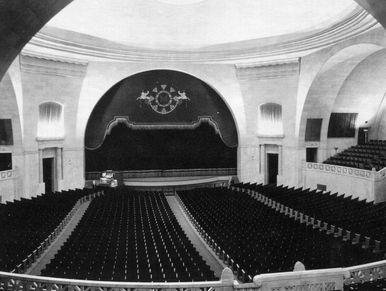Largest Pilcher Pipe Organ in the World
The Henry Pilcher’s Sons Opus 1454 organ at Memorial Auditorium is the largest instrument constructed by that firm who built organs in Louisvillebetween 1874 and 1944. In addition to the many instruments which dot the Kentucky countryside, they provided quality installations in the far reaches of the U.S., including several in Texas, Californiaand New York.
The Memorial Auditorium installation is no exception to their legacy. In fact, it’s core tonal philosophies, while reflecting those of it’s time, calling for warm “orchestral” voicing, was not limited by this factor as were many contemporary instruments. It was quite capable of rendering the vast repertoire available for organs. It’s placement in the four corners of the room provided a unique quadraphonic experience before the invention of stereophonic recordings. It was considered the pride and joy of the Louisville music scene at the time, and some of the greatest world-class organists have graced it’s bench, including Charles Courboin (organist of St. Patrick’s Cathedral, NYC), Marcel Dupre (Organist of St. Sulpice, Paris), E. Power Biggs and others
Major parts of the switching relay were damaged in the 1937 flood and Pilcher was called in to rectify the situation. The hundreds of feet of wind ducting in the basement was removed and cleaned and parts of the organ were rewired. In order to avoid further damage, the complex coupling mechanism, with tens of leathered pneumatic switches, was relocated to the small room offstage.
According to existing newspaper clippings, in 1954 the organ became a subject of debate as Auditorium leaders sought to address the acoustical situation of the Auditorium. With its grandiose dome and large archways, the reverberant space was ideal for music recitals but poor for spoken word events. Leaders therefore sought to find a compromise which would aid the acoustics without hampering the organ.
Unfortunately, under the advisement of a single acoustical engineer, who was not an organ builder, the organ was declared obsolete and the Board elected not to take the organ into consideration when the current configuration of the Auditorium was engineered. As a result, the Great and Swell Tone Chambers at the front of the room were lowered so far that direct egress of sound is greatly attenuated and the Pedal and Orchestral Chambers, speaking out into the large side balconies, no longer directly speak into the Auditorium proper at all. At this point, the use of the organ for recitals by distinguished artists ceased, and regular maintenance of the instrument was also eventually discontinue
The organ was “rediscovered” sometime in the late 1970’s by William (Mr. Pilcher) Bauer who, together with the young local organists Timothy Baker and Philip Hines, made some cursory repairs to keep the instrument playable. Other builders were occasionally called in to address issues, such as Gottfried Reck, Sam Bowerman and Peter Webber. The organ was featured in the 1993 Organ Historical Society convention.
After William Bauer’s death, a foundation was set up in his name for the purpose of caring for the needs of the instrument. Funds were raised through silent film playing and recitals. In 2012, enough funds were available to rebuild the console and switching relay, which had become increasingly problematic as the pneumatic switches deteriorated. Sam Bowerman took the project on, working mostly pro bono. As he had been undergoing treatment for what would become fatal cancer, this project would outlive him and passed to his assistant Bob Martin, who also succumbed to cancer while finishing the projec
In October of 2014, David C. Schroth, Jr. of D. C. Schroth Organ Builders, LLC took over as project manager. Meeting weekly for over a year, our small crew of volunteers was able to get the console and relay nearly fully functional. We also were able to reinstall components which had been removed in the Solo Division by Sam and Bob, and rebuild a regulator which had been damaged by water from the leaking roof.
Meanwhile, an ice storm caused severe water damage in the orchestral division of the organ, requiring the remanufacturing of several large components and the rebuilding of one regulator. These components are now nearly ready for installation.
Getting past the immediate needs of the instrument, there are other issues which loom in the future, some are mere mechanical problems and others controlled by external factors. The organ was severely hampered by the renovation of 1954. While being fully aware that turning back the clock is not possible, the hope for the future is that corrections can be made to improve the egress of sound from the instrument. There are only limited solutions to help some of the voices project as they should. The problem remains that much of the finer parts of the organ speak into a wall.
The future and continued renovation of the pipe organ, along with financial resources, will be overseen by the continued work of Mr. Schroth and Tim Baker, as the leader of the foundation whose sole purpose is to complete the work while ensuring the organ is enjoyed by future generations.
D.C. Schroth Organ Builders
WWI MEMORIAL AUDITORIUM
Henry Pilcher’s Sons
1929 – Opus 1454
Louisville, KY
Being the magnum opus of the firm of Henry Pilcher’s Sons, the magnificent instrument in the WWI Memorial Auditorium was held in high esteem by many of the famous organists who graced it’s console, including Charles Courboin and Marcel Dupre, who no-doubt marveled at the vast tonal resources, complimented by the auditorium’s resounding acoustics.
After the auditorium was renovated in 1954, which left much of the organ blocked off to the auditorium, the instrument fell into neglect. Thankfully, the William H. Bauer Foundation was set up to bring the organ back into the light, providing funds for maintenance and restoration.
Photos
December 2020 Virtual Christmas Concert
Louisville Memorial Auditorium Foundation, Inc.
1009 South Fourth Street, Louisville, KY 40203
Copyright © 2021 Louisville Memorial Auditorium Foundation, Inc.
All Rights Reserved.






